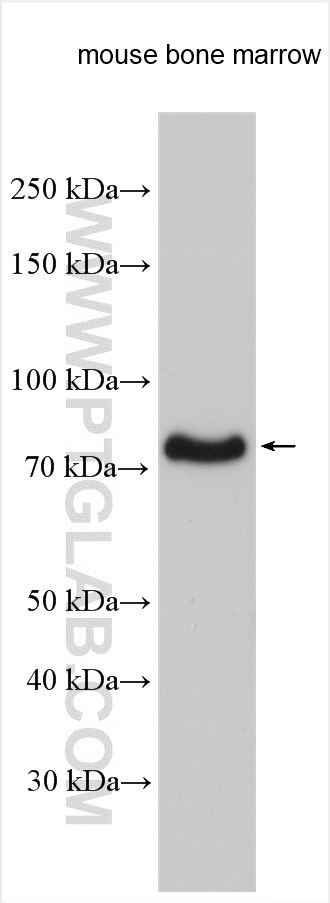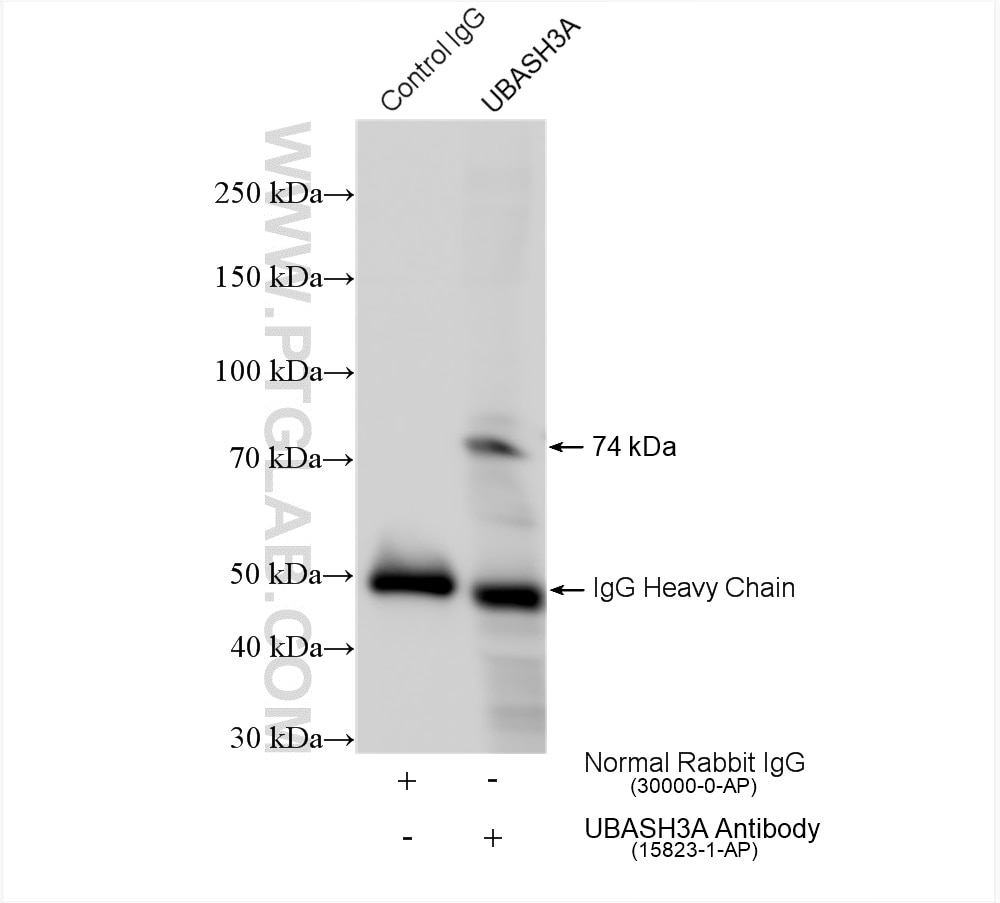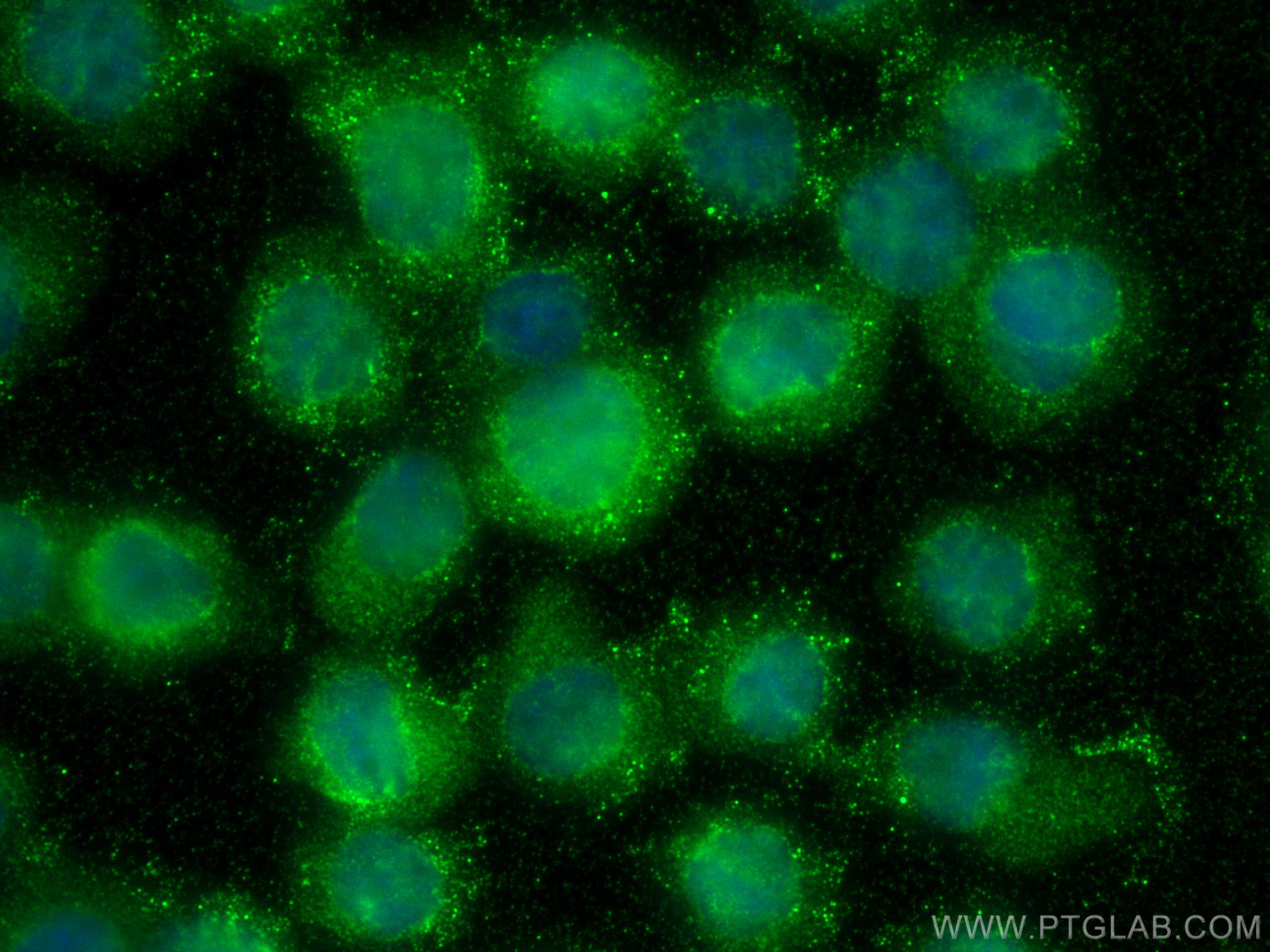Anticorps Polyclonal de lapin anti-UBASH3A-Specific
UBASH3A-Specific Polyclonal Antibody for WB, IP, IF, ELISA
Hôte / Isotype
Lapin / IgG
Réactivité testée
Humain, rat, souris
Applications
WB, IF/ICC, IP, ELISA
Conjugaison
Non conjugué
N° de cat : 15823-1-AP
Synonymes
Galerie de données de validation
Applications testées
| Résultats positifs en WB | moelle osseuse de souris, |
| Résultats positifs en IP | tissu splénique de souris, |
| Résultats positifs en IF/ICC | cellules THP-1, |
Dilution recommandée
| Application | Dilution |
|---|---|
| Western Blot (WB) | WB : 1:1000-1:8000 |
| Immunoprécipitation (IP) | IP : 0.5-4.0 ug for 1.0-3.0 mg of total protein lysate |
| Immunofluorescence (IF)/ICC | IF/ICC : 1:200-1:800 |
| It is recommended that this reagent should be titrated in each testing system to obtain optimal results. | |
| Sample-dependent, check data in validation data gallery | |
Applications publiées
| WB | See 6 publications below |
Informations sur le produit
15823-1-AP cible UBASH3A-Specific dans les applications de WB, IF/ICC, IP, ELISA et montre une réactivité avec des échantillons Humain, rat, souris
| Réactivité | Humain, rat, souris |
| Réactivité citée | Humain, souris |
| Hôte / Isotype | Lapin / IgG |
| Clonalité | Polyclonal |
| Type | Anticorps |
| Immunogène | Peptide |
| Nom complet | ubiquitin associated and SH3 domain containing, A |
| Masse moléculaire calculée | 74 kDa |
| Poids moléculaire observé | 70-74 kDa |
| Numéro d’acquisition GenBank | NM_018961 |
| Symbole du gène | UBASH3A |
| Identification du gène (NCBI) | 53347 |
| Conjugaison | Non conjugué |
| Forme | Liquide |
| Méthode de purification | Purification par affinité contre l'antigène |
| Tampon de stockage | PBS avec azoture de sodium à 0,02 % et glycérol à 50 % pH 7,3 |
| Conditions de stockage | Stocker à -20°C. Stable pendant un an après l'expédition. L'aliquotage n'est pas nécessaire pour le stockage à -20oC Les 20ul contiennent 0,1% de BSA. |
Informations générales
UBASH3A gene encodes ubiquitin-associated and SH3 domain-containing protein A (UBASH3A) also known as T-cell ubiquitin ligand 1 (TULA1) which is one of two family members belonging to the T-cell ubiquitin ligand (TULA) family. UBASH3A gene expression is limited to only a few tissues, with its highest expression in spleen, peripheral blood leukocytes, and bone marrow. UBASH3A protein is associated with c-Cbl and ubiquitylated proteins and has been implicated in the regulation of signaling mediated by protein-tyrosine kinases oth family members can negatively regulate T-cell signaling. UBASH3A can facilitate growth factor withdrawal-induced apoptosis in T cells via its interaction with apoptosis-inducing factor (AIF). This antibody is UBASH3A-specific.
Protocole
| Product Specific Protocols | |
|---|---|
| WB protocol for UBASH3A-Specific antibody 15823-1-AP | Download protocol |
| IF protocol for UBASH3A-Specific antibody 15823-1-AP | Download protocol |
| IP protocol for UBASH3A-Specific antibody 15823-1-AP | Download protocol |
| Standard Protocols | |
|---|---|
| Click here to view our Standard Protocols |
Publications
| Species | Application | Title |
|---|---|---|
Diabetes UBASH3A Mediates Risk for Type 1 Diabetes Through Inhibition of T-Cell Receptor-Induced NF-κB Signaling. | ||
Int J Mol Sci UBASH3A Interacts with PTPN22 to Regulate IL2 Expression and Risk for Type 1 Diabetes | ||
BMC Cancer FLI1 induces erythroleukemia through opposing effects on UBASH3A and UBASH3B expression | ||
Immunity TCR signaling promotes formation of an STS1-Cbl-b complex with pH-sensitive phosphatase activity that suppresses T cell function in acidic environments | ||
Int J Mol Sci STS1 and STS2 Phosphatase Inhibitor Baicalein Enhances the Expansion of Hematopoietic and Progenitor Stem Cells and Alleviates 5-Fluorouracil-Induced Myelosuppression |




